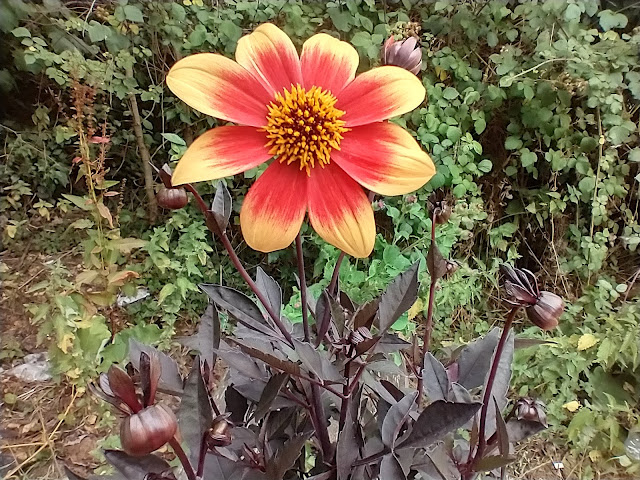RHS Radish Trial
For the past few weeks I've been taking part in the Royal Horticultural Society (RHS) Radish Trial. Each year, the RHS trials certain vegetables, fruits and flowers to see which ones should be awarded the prestigious RHS Award of Garden Merit (AGM). This award recognises those cultivars which are the best performers for home gardening, based on the following criteria:
- It must be of outstanding excellence for ordinary garden decoration or use
- It must be available
- It must be of good constitution
- It must not require highly specialist growing conditions or care
- It must not be particularly susceptible to any pest or disease
- It must not be subject to an unreasonable degree of reversion in its vegetative or floral characteristics
Most of the trials are conducted at the trials grounds at Wisley. However, some are extended to include the results from volunteer growers all over the country. I think this is an excellent idea as it gives a better indication of the best performers over a wider area of the country. This year it's the turn of the humble radish and 300 growers have been involved. I trialled the varieties Rudi (round rooted) and Mirabeau (long rooted). Both have been awarded the AGM already, but this doesn't mean the award is permanent. Cultivars are constantly retested as their performance may change over time or may be superceded by new introductions.
As radishes are an easy crop to grow, the trials questionaire has been simple to complete and consisted of:
- Names of the two varieties grown (1 round and 1 long rooted variety)
- Date sown
- Where sown - ground or container (I used a container so I could control variables such as soil, water and pest attack more easily and I could keep a daily eye on progress)
- Germination percentage
- How many became useable radishes
- Taste test
- Favourite radish and why
- Other comments
Looking back at the above photo at the start of the trial, I'm surprised at the difference between the two varieties and how it changed over time. Mirabeau looked the better radish back then - it germinated more quickly and grew away strongly. However, Rudi had a slightly better germination rate (100% to 93%) and soon overtook Mirabeau in the growth stakes. Both varieties produced 100% useable radishes. Of course taste is subjective - they both tasted mild (not hot) to me with Rudi having a crisp texture and Mirabeau slightly chewy. I liked the taste of both, but preferred Rudi overall because of its crisper texture.
I've e-mailed my assessment now. A trials website was also set up, including a forum for volunteers (not used much - I suspect because the trial was so straightforward) to post questions and comments about the trial. It's been fun to take part in something I strongly believe in. There has been some criticism recently about the relevance of trials conducted at Wisley for gardeners in some parts of the country e.g. Scotland where growing conditions can differ greatly to those in the south. Indeed, a separate Scottish award has been suggested in some quarters. If gardeners from around the country can become more involved in the RHS trials, then I think this should strengthen the award - as long as the scientific rigour of the trial isn't compromised.
For me, it also feels like things have come full circle a little. For my 'A' Level Biology project I investigated the effects of insecticides on plants. I needed a quick growing, repeatable crop that didn't take up much space in the school greenhouse for my experiments and so choose the humble radish - French Breakfast that time. I did find some significant effects too - at the cellular level. The insecticide treated crops had much larger, distorted cells, even though the size and weight of the crops were the same. Unfortunately I didn't have access to the kind of equipment needed to see if there were chemical differences. I wonder what results I'd get today?
The RHS has extensive details of its trials on their website, including their trials open days. I'm very tempted to go to one of these later this year, particularly the Dahlia one in September as Fergus Garrett will be giving a talk and the fee also includes entrance to Great Dixter, another of my 'must see' gardens.











I think it an excellent idea to use volunteers from all over the country to try out things. That way you get a far more reliable result. For me crips is very important in a radish too.
ReplyDeleteAnd yes, without doubt, go and see Great Dixter it's, well, great. :-)
I hope you get to see Great Dixter it is at the top of my list of gardens to see - one day! Hope you go and post us lots of pictures and your impressions. Sometimes gardens we know via books TV etc can be a disappointment.
ReplyDeleteI would also like to visit Wisley, though I think more than a day would be needed.
Best wishes Sylvia (England)
cor blimey they can take AGM's away??? amazing the stuff i learn from you mdear.
ReplyDeletePS another amazing thing -
ReplyDeletethat pinks and carnations day was free! And it was hilarious. Why are dahlia £25??? just fergus?
Yolanda - I've said I'd like to take part in future trials, so fingers crossed.
ReplyDeleteSylvia - I haven't been to Wisley either and I think you're right, it's going to need a week's holiday to see everything in that area!
Emma - yep, they can. Only too glad to be of service :) I saw lots of other days are free too - earlier this year. Not sure if I can wait that long until next year though...